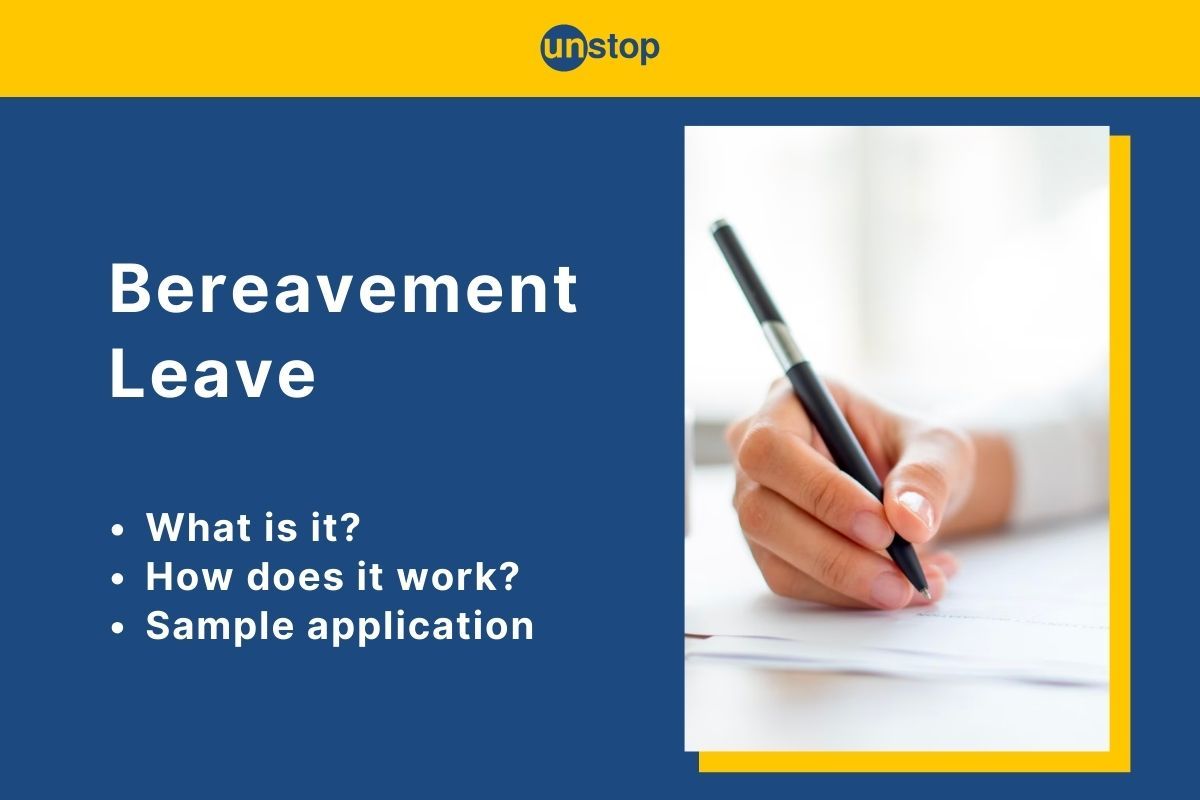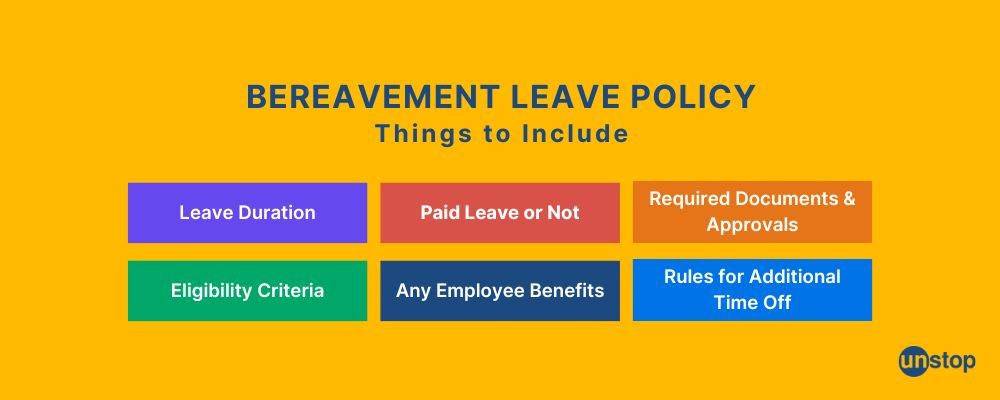- Bereavement Leave Meaning
- Bereavement Leave: Why Is It Important?
- Bereavement Leave Policy: How Does It Work?
- How To Apply For Bereavement Leave?
- Bereavement Leave Application Sample
- Conclusion
- Frequently Asked Questions (FAQs)
Bereavement Leave: What Is it & How Does It Work (With Sample Application)

Organizations offer employees several different types of leave to help them achieve a work-life balance. These leave options allow employees to take time off for important work, major life events, or just to generally enjoy a break from work.
The different leave types also help employees cope with unpredictable events. One such unforeseen circumstance is the death of a loved one or close family member. Companies offer bereavement leave to help employees cope with this tragic situation.
In this article, we'll study bereavement leave, its process, policy, and importance, as well as the application format, in detail. Read ahead.
Bereavement Leave Meaning
Losing a close, personal friend or relative can be a devastating loss. It can impact a person's emotional and mental health, leaving them ill-equipped to work.
When a family member dies, a person may also have to deal with different immediate responsibilities—such as organizing the funeral program and/or memorial services. Thus, any professional will require time off work to navigate this difficult time. This is where bereavement leave comes in handy.
Beareavement Leave Meaning: A leave that an organization offers its employees to deal with the loss of a family member or friend is referred to as bereavement leave. This leave is offered to help the employee deal with practical arrangements and process the emotional and mental pain of the loss.
Bereavement Leave: Why Is It Important?
Here’s why bereavement leave, also known as compassionate leave, is so important:
1. Emotional Well-being
The loss of a loved one can have a profound emotional impact. Bereavement leave offers employees the necessary time to process their grief without the added stress of work obligations. It acknowledges the need for emotional healing, allowing employees to return to work in a better state of mind.
2. Mental Health Considerations
Grief can lead to anxiety, depression, and other mental health issues. Bereavement leave supports mental health by giving employees space to cope with their emotions, reducing the likelihood of long-term psychological effects.
3. Improved Employee Morale and Loyalty
Providing bereavement leave shows that an organization values its employees beyond their professional contributions. This support fosters a sense of loyalty and respect, improving overall employee morale and job satisfaction.
4. Maintaining Productivity
Allowing employees time off to grieve can actually help maintain productivity in the long run. Employees who are forced to work through their grief may be less focused, leading to mistakes and lower productivity. Bereavement leave ensures that when employees return to work, they are more capable of contributing effectively.
5. Cultural Sensitivity and Inclusivity
Bereavement leave policies that accommodate different cultural and religious practices surrounding death show respect for diversity in the workplace. This inclusivity is crucial in fostering a supportive work environment.
6. Legal and Ethical Responsibility
In some regions, providing bereavement leave is a legal requirement. Beyond legal obligations, it is also an ethical responsibility for employers to support their employees during such difficult times.
7. Practical Necessities
Following a death, there are often practical matters that require attention, such as arranging a funeral, managing the deceased’s estate, and taking care of other family members. Bereavement leave allows employees to handle these responsibilities without the added pressure of work deadlines.
Ultimately, bereavement leave is essential for supporting employees during one of life’s most challenging experiences. It promotes emotional and mental well-being, maintains productivity, and reflects an organization’s commitment to its people. Providing time to grieve not only helps employees heal but also builds a stronger, more compassionate workplace.
Bereavement Leave Policy: How Does It Work?
Broadly, the purpose of a bereavement leave is to support employees through a difficult, personal ordeal. The bereavement policy differs from company to company and even between countries. Thus, it's crucial that employees study the bereavement leave policy document in detail and understand the details. In case of any confusion, employees can reach out to the Human Resources team and ask for clarification.
A bereavement leave policy enables organizations to support their employees, while also having a plan in place to deal with an employee's sudden absence from work.
What's included in the bereavement policy?

If a company has a bereavement policy in place, it should ideally, include the following information:
If a company has a bereavement policy in place, it should, ideally, include the following information:
i) Days of bereavement leave
The formal policy should clearly specify the total duration of leave. Ideally, employees should be provided adequate time to deal with the loss. Companies usually offer anywhere between three to fourteen days of leave or more. The average duration is usually seven days - but depended on factors such as the nature of employee’s relationship with the deceased family member.
For example, if a member of the extended family (like a distant aunt) dies, the duration of bereavement leave may be shorter than if a member of the immediate family (like a spouse) dies.
In some cases, employees may require fragmented time off work since certain religious ceremonies may take place several days after the funeral ceremony. The policy should specify if the bereavement leave includes additional time off.
ii) Is it paid?
Companies need to specify if they're offering paid or unpaid bereavement leave. Most companies offer paid time off for bereavement leave so the employee does not suffer from loss of pay for taking a leave of absence for a tragic event.
iii) What documents and approvals are required?
The policy should list the documents and approvals required for availing bereavement leave. Documents may include proof of death (like a death certificate), a public funeral notice, etc. In most cases, employees need to notify their HR rep or manager and get their reporting manager's approval. However, a few organisations may also require additional approval from the HR team.
iv) Rules about additional time
An employee may require additional time off work to deal with the loss. The policy should take that into account and specify the rules guiding additional time off work. For example, will it be unpaid time off work or paid; can casual leave or sick leave be utilized for bereavement leave, etc.?
v) Eligibility for bereavement leave
Naturally, the bereavement leave policy will need to specify the eligibility criteria. This can include information about the relationship between the deceased individual and the employee, the nature of employment (temporary or permanent employee), etc.
vi) Employee Benefits
In addition to the aforementioned information, certain organizations may offer an employee assistance program for eligible employees or other benefits, such as a flexible work schedule. Such a program helps employees cope with the loss when they return to work.
The program can even include contact information for medical health professionals if required or a buddy program to help the employee at the workplace.
If a company has a bereavement leave, it's ideally included in the employee handbook and updated regularly.
Bereavement Leave Policy in India: In India, companies are not bound by law to offer bereavement leave to employees. Though most organizations have a policy in place, in its absence, employees may apply for another type of leave and specify the reason.
How To Apply For Bereavement Leave?

Here's how you can apply for bereavement leave in your organization:
1. Inform your employer
The first and foremost step is to inform your employer—in this case, the reporting manager. You may even inform your manager informally through a text message or phone call before applying for leave in the system. This ensures that your manager is aware of your absence from work.
2. Discuss the duration of leave
Once you've informed your manager, discuss the duration of leave. If you require additional time off, inform your manager and get verbal approval before putting the request in the system.
3. Apply for the leave in the system
Post your discussion, apply for the leave in the system. If the company has a leave application system, you can apply for leave on it. Otherwise, share a leave application by email, addressing the concerned authority. Keep your HR representative or head in CC.
4. Ask for help
This is a difficult time for any employee and it's perfectly fine to ask your colleagues for help. They can step in to take over your daily tasks and even help you file the leave application if required.
Bereavement Leave Application Sample
Here's a sample bereavement leave application you can refer to:
Subject: Bereavement Leave Application
Dear _____ (Recipient's name)
This is to inform you about the sudden and tragic loss of my ___ (mention the relative) on (date), due to ___ (reason for death).
Consequently, I wish to apply for bereavement leave for a week. In my absence, ___ (PoC in your absence) can be contacted for any urgent tasks. Please approve my leave, from (date duration)
Do let me know in case any further information is required at my end.
Sincerely ____ (Your name)
Conclusion
In conclusion, bereavement leave is a critical benefit that provides employees with the necessary time to grieve and attend to matters following the loss of a loved one.
Employers must understand the importance of offering bereavement leave and have clear policies in place to support their employees during such difficult times. Organizations should communicate the format and guidelines for bereavement leave effectively to ensure that employees are aware of their entitlements and can make use of this important benefit when needed.
Frequently Asked Questions (FAQs)
1. Is bereavement leave paid?
No mandatory rule or law specifies that bereavement leave should be paid. However, most companies offer paid time off from work for bereaved leave.
2. Who's included in immediate family in a bereavement leave policy?
The eligibility criteria may differ between companies, but generally, bereavement leave policies include the following in the list of immediate and close family members:
- Parents
- Spouse
- Children
- In-Laws
- Grandparents
3. How much bereavement leave are employees entitled to?
Employees often want to know the duration of bereavement leave for which they are eligible. This can vary based on company policies, local labor laws, and the relationship to the deceased (e.g., immediate family member or close friend).
4. Which family members are considered eligible for bereavement leave?
The bereavement leave policy typically covers immediate family members such as parents, siblings, spouses, and children, but definitions may vary. Eligibility may also vary based on company policies.
5. What do companies mean by proof of loss?
Proof of loss refers to documents that employees need to submit when requesting bereavement leave. These can include either a death certificate, a prayer card, a funeral notice, etc.
6. Is bereavement leave different from compassionate leave?
Most organizations use the terms bereavement leave and compassionate leave interchangeably. However, in some cases, the two may mean different things. While bereavement leave may include leave due to the death of a relative or friend, compassionate leave may include time off for other reasons, such as caring for a sick child.
7. Can bereavement leave be taken intermittently or consecutively?
Companies usually offer both options, but it's essential to communicate your preferences with your supervisor and follow the established procedures.
8. How soon after the loss can an employee take bereavement leave?
Employees can typically take bereavement leave immediately after the loss in most organizations, though policies may vary. However, it’s important that the employees notify their supervisor or HR as soon as possible to initiate the process.
9. Are there any additional support services available during bereavement?
Companies may offer additional resources, such as counseling services or employee assistance programs, to support individuals going through a bereavement period.
10. Can bereavement leave be extended if needed?
Yes, in certain situations, bereavement leave can be extended. Employees should discuss their circumstances with HR, and they will guide them through the process.
Suggested Reads:
- How To Write A One-Day Leave Application For Office?
- Leave Application For Sister’s Wedding With Samples
- Writing A Leave Application For Marriage (With Template & Examples)
- Know Everything About Casual Leaves: Meaning, Types, Application Format & Samples
- How To Write A Maternity Leave Application: Find Format, Samples, Do's & Don'ts
I’m a reader first and a writer second, constantly diving into the world of content. If I’m not writing or reading, I like watching movies and dreaming of a life by the beach.
Login to continue reading
And access exclusive content, personalized recommendations, and career-boosting opportunities.
Subscribe
to our newsletter
Blogs you need to hog!

How To Write Finance Cover Letter For Morgan Stanley (+Free Sample!)

55+ Data Structure Interview Questions For 2025 (Detailed Answers)

How To Negotiate Salary With HR: Tips And Insider Advice













Comments
Add comment